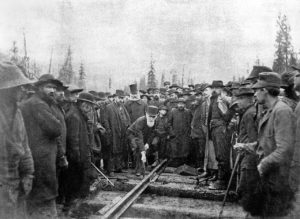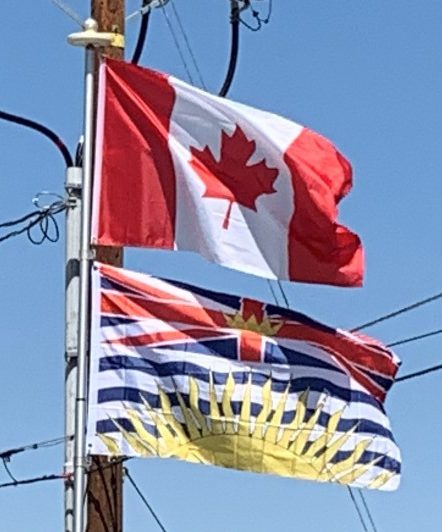With the agreement by the Canadian government to extend the Canadian Pacific Railway to British Columbia and to assume the colony’s debt, British Columbia became the sixth province to join Confederation on July 20, 1871. The borders of the province were not completely settled. The Treaty of Washington sent the Pig War San Juan Islands Border dispute to arbitration in 1871 and in 1903, the province’s territory shrank again after the Alaska boundary dispute settled the vague boundary of the Alaska Panhandle.
Population in British Columbia continued to expand as the province’s mining, forestry, agriculture, and fishing sectors were developed. Mining activity was particularly notable throughout the Mainland, so much so a common epithet for the Mainland, even after provincehood, was “the Gold Colony”. Agriculture attracted settlers to the fertile Fraser Valley, and cattle ranchers and later fruit growers came to the drier grasslands of the Thompson River area, the Cariboo, the Chilcotin, and the Okanagan. Forestry drew workers to the lush temperate rainforests of the coast, which was also the locus of a growing fishery.

The completion of the railway in 1885 was a huge boost to the province’s economy, facilitating the transportation of the region’s considerable resources to the east. The milltown of Granville, known as Gastown, near the mouth of the Burrard Inlet was selected as the terminus of the railway, prompting the incorporation of the City as Vancouver in 1886. The completion of the Port of Vancouver spurred rapid growth, and in less than fifty years the city surpassed Winnipeg, Manitoba, as the largest in Western Canada.
Meanwhile, the province continued to grow. In 1914, the last spike of a second transcontinental rail line, the Grand Trunk Pacific, linking north-central British Columbia from the Yellowhead Pass through Prince George to Prince Rupert was driven at Fort Fraser. This opened up the North Coast and the Bulkley Valley region to new economic opportunities. What had previously been an almost exclusively fur trade and subsistence economy soon became a locus for forestry, farming, and mining.
In World War I, the province responded strongly to the call to assist the British Empire against its German foes in French and Belgian battlefields. About 55,570 of the 400,000 British Columbian residents, the highest per-capita rate in Canada, responded to the military needs. Horseriders from the province’s Interior region and First Nations soldiers made contributions to Vimy Ridge and other battles. About 6,225 men from the province died in combat.
1920s to 1940s:
When the men returned from the First World War, they discovered the recently enfranchised women of the province had helped vote in the prohibition of liquor in an effort to end the social problems associated with the hard-core drinking Vancouver and the rest of the province was famous for until the war. Because of pressure from veterans, prohibition was quickly relaxed so the “soldier and the working man” could enjoy a drink, but widespread unemployment among veterans was hardened by many of the available jobs being taken by European immigrants and disgruntled veterans organized a range of “soldier parties” to represent their interests, variously named Soldier-Farmer, Soldier-Labour, and Farmer-Labour Parties. These formed the basis of the fractured labor-political spectrum that would generate a host of fringe leftist and rightist parties, including those who would eventually form the Co-operative Commonwealth and the early Social Credit splinter groups.
